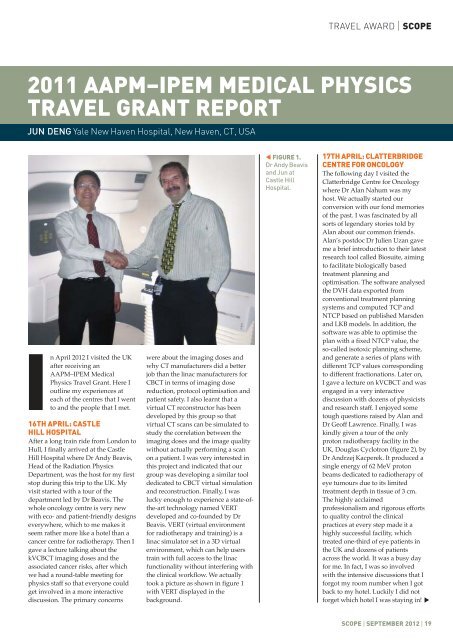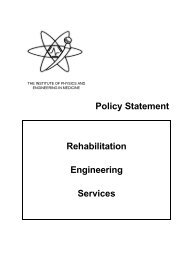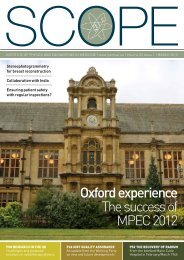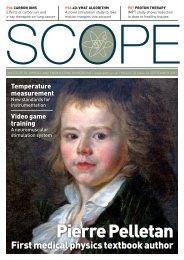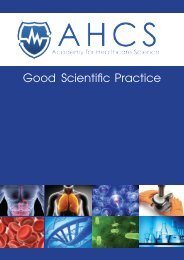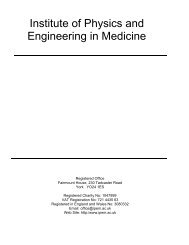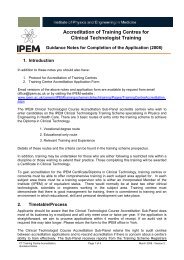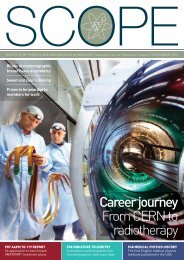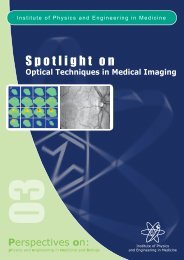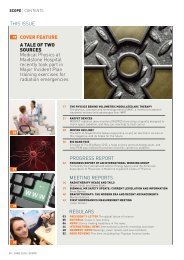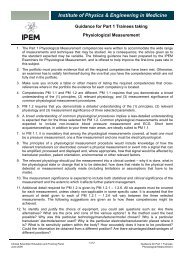Experience the Elekta Differ - Institute of Physics and Engineering in ...
Experience the Elekta Differ - Institute of Physics and Engineering in ...
Experience the Elekta Differ - Institute of Physics and Engineering in ...
You also want an ePaper? Increase the reach of your titles
YUMPU automatically turns print PDFs into web optimized ePapers that Google loves.
2011 AAPM–IPEM MEDICAL PHYSICS<br />
TRAVEL GRANT REPORT<br />
JUN DENG Yale New Haven Hospital, New Haven, CT, USA<br />
I<br />
n April 2012 I visited <strong>the</strong> UK<br />
after receiv<strong>in</strong>g an<br />
AAPM–IPEM Medical<br />
<strong>Physics</strong> Travel Grant. Here I<br />
outl<strong>in</strong>e my experiences at<br />
each <strong>of</strong> <strong>the</strong> centres that I went<br />
to <strong>and</strong> <strong>the</strong> people that I met.<br />
16TH APRIL: CASTLE<br />
HILL HOSPITAL<br />
After a long tra<strong>in</strong> ride from London to<br />
Hull, I f<strong>in</strong>ally arrived at <strong>the</strong> Castle<br />
Hill Hospital where Dr Andy Beavis,<br />
Head <strong>of</strong> <strong>the</strong> Radiation <strong>Physics</strong><br />
Department, was <strong>the</strong> host for my first<br />
stop dur<strong>in</strong>g this trip to <strong>the</strong> UK. My<br />
visit started with a tour <strong>of</strong> <strong>the</strong><br />
department led by Dr Beavis. The<br />
whole oncology centre is very new<br />
with eco- <strong>and</strong> patient-friendly designs<br />
everywhere, which to me makes it<br />
seem ra<strong>the</strong>r more like a hotel than a<br />
cancer centre for radio<strong>the</strong>rapy. Then I<br />
gave a lecture talk<strong>in</strong>g about <strong>the</strong><br />
kVCBCT imag<strong>in</strong>g doses <strong>and</strong> <strong>the</strong><br />
associated cancer risks, after which<br />
we had a round-table meet<strong>in</strong>g for<br />
physics staff so that everyone could<br />
get <strong>in</strong>volved <strong>in</strong> a more <strong>in</strong>teractive<br />
discussion. The primary concerns<br />
were about <strong>the</strong> imag<strong>in</strong>g doses <strong>and</strong><br />
why CT manufacturers did a better<br />
job than <strong>the</strong> l<strong>in</strong>ac manufacturers for<br />
CBCT <strong>in</strong> terms <strong>of</strong> imag<strong>in</strong>g dose<br />
reduction, protocol optimisation <strong>and</strong><br />
patient safety. I also learnt that a<br />
virtual CT reconstructor has been<br />
developed by this group so that<br />
virtual CT scans can be simulated to<br />
study <strong>the</strong> correlation between <strong>the</strong><br />
imag<strong>in</strong>g doses <strong>and</strong> <strong>the</strong> image quality<br />
without actually perform<strong>in</strong>g a scan<br />
on a patient. I was very <strong>in</strong>terested <strong>in</strong><br />
this project <strong>and</strong> <strong>in</strong>dicated that our<br />
group was develop<strong>in</strong>g a similar tool<br />
dedicated to CBCT virtual simulation<br />
<strong>and</strong> reconstruction. F<strong>in</strong>ally, I was<br />
lucky enough to experience a state-<strong>of</strong><strong>the</strong>-art<br />
technology named VERT<br />
developed <strong>and</strong> co-founded by Dr<br />
Beavis. VERT (virtual environment<br />
for radio<strong>the</strong>rapy <strong>and</strong> tra<strong>in</strong><strong>in</strong>g) is a<br />
l<strong>in</strong>ac simulator set <strong>in</strong> a 3D virtual<br />
environment, which can help users<br />
tra<strong>in</strong> with full access to <strong>the</strong> l<strong>in</strong>ac<br />
functionality without <strong>in</strong>terfer<strong>in</strong>g with<br />
<strong>the</strong> cl<strong>in</strong>ical workflow. We actually<br />
took a picture as shown <strong>in</strong> figure 1<br />
with VERT displayed <strong>in</strong> <strong>the</strong><br />
background.<br />
FIGURE 1.<br />
Dr Andy Beavis<br />
<strong>and</strong> Jun at<br />
Castle Hill<br />
Hospital.<br />
▼<br />
TRAVEL AWARD | SCOPE<br />
17TH APRIL: CLATTERBRIDGE<br />
CENTRE FOR ONCOLOGY<br />
The follow<strong>in</strong>g day I visited <strong>the</strong><br />
Clatterbridge Centre for Oncology<br />
where Dr Alan Nahum was my<br />
host. We actually started our<br />
conversion with our fond memories<br />
<strong>of</strong> <strong>the</strong> past. I was fasc<strong>in</strong>ated by all<br />
sorts <strong>of</strong> legendary stories told by<br />
Alan about our common friends.<br />
Alan’s postdoc Dr Julien Uzan gave<br />
me a brief <strong>in</strong>troduction to <strong>the</strong>ir latest<br />
research tool called Biosuite, aim<strong>in</strong>g<br />
to facilitate biologically based<br />
treatment plann<strong>in</strong>g <strong>and</strong><br />
optimisation. The s<strong>of</strong>tware analysed<br />
<strong>the</strong> DVH data exported from<br />
conventional treatment plann<strong>in</strong>g<br />
systems <strong>and</strong> computed TCP <strong>and</strong><br />
NTCP based on published Marsden<br />
<strong>and</strong> LKB models. In addition, <strong>the</strong><br />
s<strong>of</strong>tware was able to optimise <strong>the</strong><br />
plan with a fixed NTCP value, <strong>the</strong><br />
so-called isotoxic plann<strong>in</strong>g scheme,<br />
<strong>and</strong> generate a series <strong>of</strong> plans with<br />
different TCP values correspond<strong>in</strong>g<br />
to different fractionations. Later on,<br />
I gave a lecture on kVCBCT <strong>and</strong> was<br />
engaged <strong>in</strong> a very <strong>in</strong>teractive<br />
discussion with dozens <strong>of</strong> physicists<br />
<strong>and</strong> research staff. I enjoyed some<br />
tough questions raised by Alan <strong>and</strong><br />
Dr Ge<strong>of</strong>f Lawrence. F<strong>in</strong>ally, I was<br />
k<strong>in</strong>dly given a tour <strong>of</strong> <strong>the</strong> only<br />
proton radio<strong>the</strong>rapy facility <strong>in</strong> <strong>the</strong><br />
UK, Douglas Cyclotron (figure 2), by<br />
Dr Andrzej Kacperek. It produced a<br />
s<strong>in</strong>gle energy <strong>of</strong> 62 MeV proton<br />
beams dedicated to radio<strong>the</strong>rapy <strong>of</strong><br />
eye tumours due to its limited<br />
treatment depth <strong>in</strong> tissue <strong>of</strong> 3 cm.<br />
The highly acclaimed<br />
pr<strong>of</strong>essionalism <strong>and</strong> rigorous efforts<br />
to quality control <strong>the</strong> cl<strong>in</strong>ical<br />
practices at every step made it a<br />
highly successful facility, which<br />
treated one-third <strong>of</strong> eye patients <strong>in</strong><br />
<strong>the</strong> UK <strong>and</strong> dozens <strong>of</strong> patients<br />
across <strong>the</strong> world. It was a busy day<br />
for me. In fact, I was so <strong>in</strong>volved<br />
with <strong>the</strong> <strong>in</strong>tensive discussions that I<br />
forgot my room number when I got<br />
back to my hotel. Luckily I did not<br />
forget which hotel I was stay<strong>in</strong>g <strong>in</strong>!<br />
▼<br />
SCOPE | SEPTEMBER 2012 | 19


